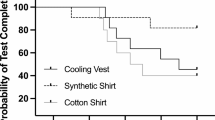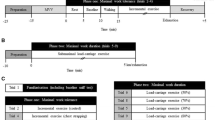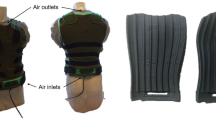Abstract
Protective vests worn by global security personnel, and weighted vests worn by athletes, may increase physiological strain due to added load, increased clothing insulation and vapor resistance. The impact of protective vest clothing properties on physiological strain, and the potential of a spacer garment to reduce physiological strain, was examined. Eleven men performed 3 trials of intermittent treadmill walking over 4 h in a hot, dry environment (35°C, 30% rh). Volunteers wore the US Army battledress uniform (trial B), B + protective vest (trial P), and B + P + spacer garment (trial S). Biophysical clothing properties were determined and found similar to many law enforcement, industry, and sports ensembles. Physiological measurements included core (T c), mean skin (T sk) and chest (T chest) temperatures, heart rate (HR), and sweating rate (SR). The independent impact of clothing was determined by equating metabolic rate in all trials. In trial P, HR was +7 b/min higher after 1 h of exercise and +19 b/min by the fourth hour compared to B (P < 0.05). T c (+0.30°C), T sk (+1.0°C) and Physiological Strain Index were all higher in P than B (P < 0.05). S did not abate these effects except to reduce T sk (P > S) via a lower T chest (−0.40°C) (P < 0.05). SR was higher (P < 0.05) in P and S versus B, but the magnitude of differences was small. A protective vest increases physiological strain independent of added load, while a spacer garment does not alter this outcome.


Similar content being viewed by others
References
Bernard TE (1999) Heat stress and protective clothing: an emerging approach from the United States. Ann Occup Hyg 43:321–327
Cadarette BS, Blanchard L, Staab JE, Kolka MA, and Sawka MN (2001) Heat stress when wearing body armor. US Army Research Institute of Environmental Medicine Technical Report No. T-01/9, Natick
Cadarette BS, Matthew WT, Sawka MN (2005) WBGT index temperature adjustments for work/rest cycles when wearing NBC protective clothing or body armor
Cheuvront SN, Carter R III, Montain SJ, Sawka MN (2004) Daily body mass variability and stability in active men undergoing exercise-heat stress. Int J Sport Nutr Exerc Metab 14:532–540
Cheuvront SN, Montain SJ, Goodman DA, Blanchard L, Sawka MN (2007) Evaluation of the limits to accurate sweat loss prediction. Eur J Appl Physiol 101:215–224
Consolazio CF, Johnson RE, Pecora LJ (1963) Physiological measurements of metabolic functions in man. McGraw Hill, New York
Departments of the Army and Air Force (2003) Heat stress control and heat casualty management. TBMED 507/UFPAM 48–152(I), Government Printing Office, Washington, DC
DuBois D, DuBois EF (1916) Clinical calorimetry: a formula to estimate the approximate surface area if height and weight be known. Arch Intern Med 17:863–871
Endrusick TL, Berglund LG, Gonzalez J, Gallimore R, Zheng J (2006) Use of a spacer vest to increase evaporative cooling under military body armor. In: Fran J (ed) Thermal manikins and modeling. The Hong Kong Polytechnic University, Hong Kong, pp 381–387
Folk GE (1974) Textbook of environmental physiology. Lea and Febiger, Philadelphia, pp 196–197
Gagge AP, Gonzalez RR (1996) Mechanisms of heat exchange: biophysics and physiology. In: Fregly MJ, Blatteis CM (eds) Handbook of physiology: environmental physiology. American Physiological Society, Bethesda, pp 45–84
Gonzalez RR (1988) Biophysics of heat transfer and clothing considerations. In: Pandolf KB, Sawka MN, Gonzalez RR (eds) Human performance physiology and environmental medicine at terrestrial extremes. Benchmark, Indianapolis, pp 45–95
Gonzalez-Alonso J, Teller C, Andersen SL, Jensen FB, Hyldig T, Nielsen B (1999) Influence of body temperature on the development of fatigue during prolonged exercise in the heat. J Appl Physiol 86:1032–1039
Greendale GA, Salem GJ, Young JT, Damesyn M, Marion M, Wang MY, Reuben DB (2000) A randomized trial of weighted vest use in ambulatory older adults: strength, performance, and quality of life outcomes. J Am Geriatr Soc 48:305–311
Havenith G (1999) Heat balance when wearing protective clothing. Ann Occup Hyg 43:289–296
Lehmacher EJ, Jansing P, Kupper T (2007) Thermophysiological responses caused by ballistic bullet-proof vests. Ann Occup Hyg 51:91–96
Levine L, Sawka MN, Gonzalez RR (1998) Evaluation of clothing systems to determine heat strain. Am Ind Hyg Assoc J 59:557–562
Lind AR, Bass DE (1963) Optimal exposure time for development of acclimatization to heat. Fed Proc 22:704–708
McCullough EA, Kenney WL (2003) Thermal insulation and evaporative resistance of football uniforms. Med Sci Sports Exerc 35: 832–837
Mitchell JW, Nadel ER, Stolwijk JAJ (1972) Respiratory weight losses during exercise. J Appl Physiol 32:474–476
Montain SJ, Sawka MN, Cadarette BS, Quigley MD, McKay JM (1994) Physiological tolerance to uncompensable heat stress: effects of exercise intensity, protective clothing, and climate. J Appl Physiol 77:216–222
Moran DS, Shitzer A, Pandolf KB (1998) A physiological strain index to evaluate heat stress. Am J Physiol 275:R129–R134
Muza SR, Pimental NA, Cosimini HM, Sawka MN (1988) Portable, ambient air microclimate cooling in simulated desert and tropic conditions. Aviat Space Environ Med 59:553–558
National Institute of Justice (2001) Selection and application guide to personal body armor. US Department of Justice, National Institute of Justice Guide 100-01, Rockford
Pandolf KB, Goldman RF (1978) Convergence of skin and rectal temperatures as a criterion for heat tolerance. Aviat Space Environ Med 49:1095–1101
Puthoff ML, Darter BJ, Nielsen DH, Yack HJ (2006) The effect of weighted vest walking on metabolic responses and ground reaction forces. Med Sci Sports Exerc 38:746–752
Ramanathan NL (1964) A new weighting system for mean surface temperature of the human body. J Appl Physiol 19:531–533
Ricciardi R, Deuster PS, Talbot LA (2007) Metabolic demands of body armor on physical performance in simulated conditions. Mil Med (in review)
Rowell LB (1986) Human circulation: regulation during physical stress. Oxford University Press, New York, pp 363–406
Rusko H, Bosco CC (1987) Metabolic response of endurance athletes to training with added load. Eur J Appl Physiol Occup Physiol 56:412–418
Sawka MN, Wenger CB, Pandolf KB (1996) Thermoregulatory responses to acute exercise-heat stress and heat acclimation. In: Fregly MJ, Blatteis CM (eds) Handbook of physiology, Section 4, environmental physiology. Oxford University Press, New York, pp 157–185
Vallerand AL, Savourey G, Hanniquet AM, Bittel JH (1992) How should body heat storage be determined in humans: by thermometry or calorimetry? Eur J Appl Physiol Occup Physiol 65:286–294
Yarger WE, Litt BD, Goldman RF (1969) Body armor in a hot humid environment. II. Studies in heat acclimatized men. Res Rep US Nav Med Field Res Lab 19:1–42
Acknowledgments
The authors wish to thank Rob Coleman and Rick Gallimore for providing the Interceptor Body Armor and spacer vests used in this study, respectively. We also thank the Biophysics and Modeling Division for manikin clothing data, Josh Bulotsky (Doriot Chamber facility), the entire Thermal and Mountain Medicine Division technical support staff, and most importantly the soldiers who volunteered their time to take part in this study. The view, opinions, and/or findings contained in this report are those of the authors and should not be construed as an official Department of the Army position, or decision, unless so designated by other official documentation. Approved for public release; distribution unlimited.
Author information
Authors and Affiliations
Corresponding author
Rights and permissions
About this article
Cite this article
Cheuvront, S.N., Goodman, D.A., Kenefick, R.W. et al. Impact of a protective vest and spacer garment on exercise-heat strain. Eur J Appl Physiol 102, 577–583 (2008). https://doi.org/10.1007/s00421-007-0632-3
Accepted:
Published:
Issue Date:
DOI: https://doi.org/10.1007/s00421-007-0632-3




